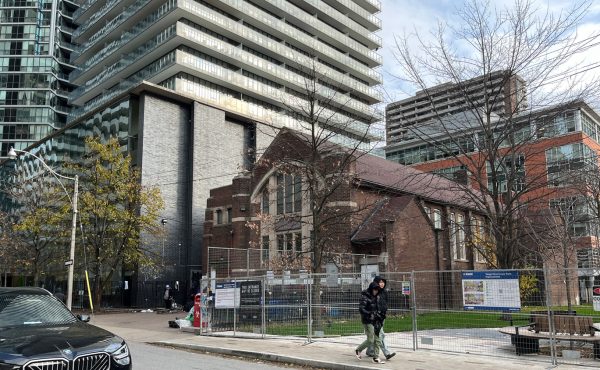Ever wish you had something to read on the subway, other than that crumpled free commuter newspaper on the floor? Three students at the Miami Ad Schoolcame up with this idea to use ads on the New York subway that can bring a small library to your smartphone.
Responding to a revolution in the way we consume books, commuter ennui, and limited cell service on the subway, the idea is fairly straightforward. Use some of the advertising space on a train to display a number of current titles, and embed near field communication (NFC) chips behind each. When a title is swiped by a smartphone, it will send a 10-page preview of the book to your phone — just enough to kill some time and get you hooked — and let you know which library branches have a copy of the entire book. It could also include links to the library catalogue with up-to-date information on availability for when you next surface.
It’s easy to see how this idea can be adapted to Toronto, or any transit system, for that matter. There are a number of library branches a stone’s throw from subway stations — the Runnymede and Bloor-Gladstone branches are no more than a block from Runnymede and Dufferin stations, while the North York Central Library connects directly to North York Centre station. Extra copies of books featured on the subway could be stocked in nearby branches to ensure availability.
The TTC is also slowly rolling out cellular and wifi service in the subway, starting with station platforms, so new mini “e-branches” could eventually include links to complete eBooks available from the Toronto Public Library’s growing digital collection. Before iPhone users get too excited, though, Apple does not include NFC technology on its phones, so swapping NFC chips for QR codes linking to websites may improve accessibility when cell reception does make it underground.
Newfangled eBooks and wireless communications technology may be a bit much for Toronto’s typically low-tech transit system, but New York has taken a bricks-and-mortar approach and built a small 2,100-square-foot public underground library branch, tucked away just outside the turnstiles at the 51st Street station on the busy Lexington Avenue line in Midtown Manhattan. The library offers a selection of fiction and non-fiction books, and passing by a dozen times a week on the way to and from work, school or home means you’re not likely to pay overdue fines too frequently.
Is this something that could work in the subway? (Or in the métro, SkyTrain, Transitway or C-Train?) Where would you like to see new “e-branches”, or where might a new branch be squeezed in? Leave us your thoughts in the comment section below.





6 comments
Sounds like an interesting idea I will definitely look in to. Just one point…..:declining public library membership”? Toronto Public Library is the highest per capita used library system in the world!
Thanks Councillor Ainslie, that would be great! I know I’d be pulling out my phone pretty quickly if I saw something like this on the subway, and judging by the number of articles I’ve seen cropping up on this idea, I don’t think I’d be the only one (I hope those students earned a good grade from all the online attention, at least). We’d love to hear more about how this kind of thing might work, and if the TPL were interested in trying it out!
The point about declining library membership was referring to New York’s public library system, not Toronto’s. A little further digging suggested that the the drop in members the NYCPL has seen in recent years is at least partially a result of major purges of inactive accounts, and that total borrowing is going strong. In any case, I’ve edited that sentence to clear up any confusion that may have caused!
Great article. As an innovation firm we’re constantly involved with and looking at the world of connected environments and embedded devices. This is an excellent example of how both can extend the meaning of public space – in this case, the library and transit – by providing a new benefit and connecting to the personal space. By the way my local – Deer Park Library, is literally right across the road from St Clair Subway. How about a similar idea for sharing music to drive discovery of new Canadian bands?
There is also the Bibliometro project in Madrid’s Metro system with mini self-serve library branches located in various stations in the network. Great for people who would prefer reading a hard copy over an e-book, especially if you’re reading it on your phone screen.
http://www.metromadrid.es/en/viaja_en_metro/Bibliometro_y_Locales_de_Ensayo/Bibliometro/
Which was featured here back in July 2011: http://spacing.ca/toronto/2011/07/29/madrid-subway-library/
Steve, a library in Iowa did that with local music. http://music.icpl.org/ The FAQ mentioned that they paid $100 per album, which a separate interview said was for a 2 year license. I haven’t read any follow up on what their stats are like though.
I remember reading about Stockholm embedding a mini-branch at a busy subway station (http://www.bostonstreetlab.org/2009/05/30/locating-libraries-in-metro-stations-stockholm/). I thought something similar – albeit much more small scale would be great for Yonge and Bloor station. Imagine being able to order your books online from any branch (like you can today) and pick them up there, or return overdue books. You could even have something like the deposit boxes they have at Sobeys now (BufferBox: https://www.bufferbox.com/faqs) – a cabinet with a bunch of locked boxes. You order a book from any branch library online, get an email when you can pick it up and the pin code, go to the box on your daily commute, type in the code (or scan the barcode) and it opens the door to a locker where your book is waiting for you…
I know I would take out library books much more often if this was the case. I know we are blessed with lots of branches in Toronto, but now I barely want to check out books because I have the experience of “never getting around to” go to return them, and ending up with a huge fine. Whereas I pass by Yonge and Bloor every day.